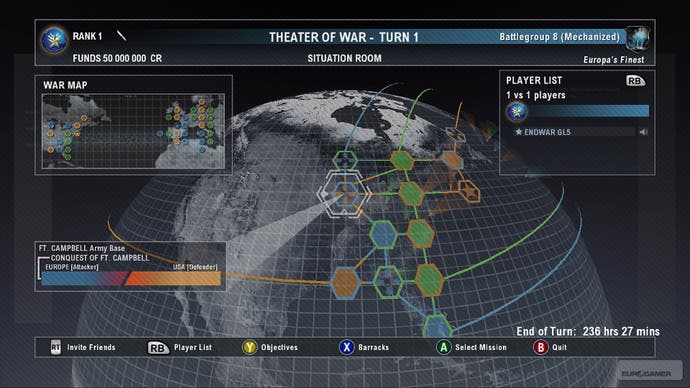Tom Clancy's EndWar
Better not have soldier headset.
The end of oil may be bad news for motorists, but it's been solid fuel for game developers, who seem to agree that the result will be superpowers jabbing nuclear fingers at one another. THQ's Frontlines toyed with the idea earlier this year, and now it's Ubisoft's turn to speculate on what might happen if Russia, Europe and the USA find themselves squabbling over diminishing natural resources.
If that's well within the Clancy comfort zone, however, EndWar itself is not. It's a console real-time strategy game, attempting to get around the issues that have dogged the genre outside of its PC home for years.
Developer Ubisoft Shanghai goes about this in two ways. The first is an intuitive two-pronged control system, ideally suited to the demands of the armchair strategist, designed to overcome the relative limitations of the control pad. Players command their forces with a superbly implemented voice-recognition system, in conjunction with a refined context-sensitive set of pad controls, and both elements are precise and fast. The lack of mouse control is no longer something to curse in the heat of battle.
The second part of the plan is to change the focus of the battle altogether, and zone in on small-scale skirmishes rather than traditional resource-gathering and research. Instead of zoomed-out overhead views and landscapes shrouded by the fog of war, the action is presented relatively close up, from a crisply detailed albeit somewhat bland 3D viewpoint just above and behind whichever unit you've selected. You can move and rotate with the left and right sticks, flick between units with the d-pad, and issue basic context-sensitive commands by moving a cursor over your target or location and clicking on it.

But much more in the spirit of things is to hook up a headset and bellow orders like a testosterone-damaged alpha-male war-pig. After a brief calibration procedure, everything from securing uplinks to switching units and taking cover becomes second nature. Holding down the right trigger, you can string together simple sentences, such as 'unit 1, secure foxtrot' or 'unit 4, attack hostile 3', which can be a lot quicker than having to manually flick between units on the d-pad, even if the pad interface is a simple and effective backup. A mixture of the two works best, with certain commands quicker on the pad and some evidently better voiced. Just make sure you have a wired headset, because the game's best played with the mic very close to your mouth to drown out the background noise. From the game. Fight in a library or something.
The actual combat, meanwhile, operates on an easy-to-follow rock-paper-scissors principle, where transports beat choppers, choppers beat tanks, and tanks beat transports. With just seven unit types to worry about (riflemen, engineers, artillery, command vehicles, tanks, transports and gunships), tactics are intuitive. You may well discover that riflemen, for example, are effective placed inside buildings first rather than fighting in the open, and good use of cover and sensible unit placement becomes important once you understand each unit's weaknesses, and the demands of certain mission types.

Missions come in four distinct flavours and the parameters are straightforward, regardless of whether you choose the Americans, Russians or Europeans. Raid involves destroying buildings or defending them for ten minutes, the goal in Conquest is to hold more than half the uplink stations for five minutes, Assault is a simple 'kill everything' battle, and Siege is about attacking or defending a critical uplink for as long as instructed. It's superficially stripped-down and basic, then, but EndWar has depth in its training and upgrade system, which allows players to apply up to 150 upgrades for each faction and rewards them for keeping experienced units alive. Points earned in each round can be used to beef up attack and defence abilities, or, for example, upgrade riflemen units to sniper units.


